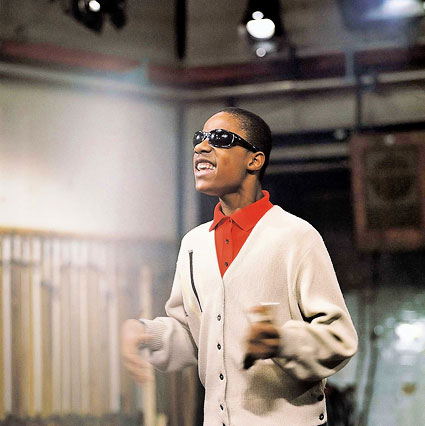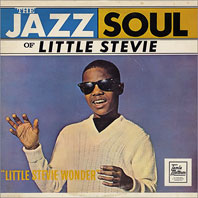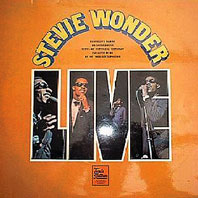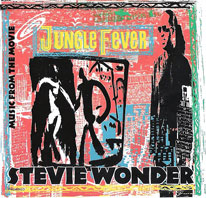
stevie wonder
b. Steveland Hardaway Judkins, 13th May 1950, Saginaw, Michigan, U.S.A.
Stevie Wonder has been a major figure within the Black Music scene over the last fifty years.
Stevie Wonder was born Steveland Judkins, however, he now prefers to be known as Steveland Morris after his mother's married name.
stevie with his mother
Placed in an incubator immediately after his birth, baby Steveland was thought to have been given too much oxygen at birth, however he was suffering from Retinopathy of Prematurity (R.O.P.).
In fact, without the oxygen that he received he would not be here. The cause was the prematurity of the eye.
Blood vessels in the back of the eye had not reached the front of the eye thus when he was born, prematurely, that growth temporarly halted then wildly took off branching out into the Vitreous of the eye.
When it reached a certain point it caused scar tissue to pull at the retina eventually causing the retina to detach.
(that piece of information was sent to me by a mother, who has a daughter suffering from the same condition as Stevie. I would like to thank that mother and send my best wishes to her daughter)
Despite this handicap, he began to learn the piano at the age of seven, and had also mastered drums and harmonica by the age of nine.
After his family moved to Detroit in 1954, Steveland joined a church choir, musically juxtaposed by the R & B of Ray Charles and Sam Cooke.
In 1961, he was discovered by Ronnie White of the Miracles, who arranged an audition at Motown Records. Berry Gordy immediately signed Steveland to the label.
clarence paul with a young stevie
Clarence Paul came up with the 'Wonder' surname stating that 'We can't keep introducing him as the '8th Wonder Of The World'.
Stevie was placed in the care of writer / producer Clarence Paul, who supervised his early recordings.
These helped him develop his talents as a multi-instrumentalist, but did not indicate a clear musical direction.
the jazz soul of little stevie - 1962 / tribute to uncle ray - 1962 / the 12 year old genius - 1963 / with a song in my heart - 1963
In 1962, the release of the live recording 'Fingertips' established his commercial success, and Motown quickly marketed him on a series of albums as 'the 12-year-old genius' in an attempt to link him with the popularity of 'the late genius', Ray Charles.
Attempts to repeat the success of 'Fingertips' proved difficult, and Wonder's career was placed on hold during 1964 while his voice was breaking.
stevie at the beach - 1964 / up-tight - 1966 / down to earth - 1966 / i was made to love her - 1967
He re-emerged in 1965 with a sound that was much closer to the Motown mainstream, achieving a worldwide hit with 'Uptight (Everything's Alright)', which he co-wrote with Henry 'Hank' Cosby and Sylvia Moy.
This began a run of U.S. Top 40 hits that continued unbroken (apart from seasonal Christmas releases) for over six years.
someday at christmas - 1967 / for once in my life - 1968 / my cherie amour - 1969 / live - 1970
From 1965-70, Stevie Wonder was marketed like the other major Motown stars, recording material that was chosen for him by the label's executives, and issuing albums that mixed conventional soul compositions with pop standards.
Stevie also recorded his versions of Bob Dylan's 'Blowin ln The Wind' and Ron Miller's 'A Place In The Sun' in 1966.
He co-wrote almost all of his singles from 1967 onwards, and also began to collaborate on releases by other Motown artists, most notably co-writing Smokey Robinson And The Miracles' hit 'The Tears Of A Clown', and writing and producing the (Motown) Spinners' 'It's A Shame'.
signed, sealed, delivered - 1970 / where i'm coming from - 1971
His contract with Motown expired in 1971, rather than re-signing immediately, as the label expected, Stevie financed the recording of two albums of his own material, playing almost all the instruments himself, and experimenting for the first time with more ambitious musical formats.
He pioneered the use of the synthesizer in Black Music, and also broadened his lyrical concerns to incompass racial problems and spiritual questions.
Stevie then used these recordings as a lever to persuade Motown to offer a more open contract, which gave him total artistic control over his music, plus the opportunity to hold the rights to the music publishing with his own company, Black Bull Music.
The signing of the contract with the release of the solo recordings 'Where I'm Coming From' and 'Music Of My Mind', which, despite lukewarm critical reaction in the British music media, quickly established him at the forefront of, not only, Black music, but mainstream music generally.
music of my mind - 1972 / talking book - 1972 / innervisions - 1973 / fulfillingness first finale - 1974
'Talking Book', in 1972, combined the technological advances of recent albums with major commercial success, producing hit singles from the funk enfused 'Superstition', to the ballad standard 'You Are The Sunshine Of My Life'.
with tonto's expanding head band ('living for the city' session)
'Innervisions' (1973) consolidated the growth and success of 'Talking Book', bringing further hit singles with the socially aware 'Living For The City' and 'Higher Ground'.
malcolm cecil and robert margouleff
For the former release, Stevie enlisted the programming skills of the Malcolm Cecil and Robert Margouleff.
Their group, Tonto's Expanding Head Band, Stevie had become interested in, regarding their creative use of synthesisers on their own recordings.
Tragedy struck later that year, when Stevie was seriously injured in a car accident.
The release of 'Fulfillingness First Finale' in 1974 realised a more thoughtful and spiritual approach to his music, showcased by the impressive 'Heaven Is 10 Zillion Light Years Away'.
'Fulfillingness' also featured 'Boogie On Reggae Woman', 'Creepin', 'They Won't Go When I Go', 'Bird Of Beauty' and 'You Haven't Done Nothin'.
with syreeta
Stevie married fellow Motown artist Syreeta on 14th September 1970, and showcased many of his new production techniques on 'Syreeta' (1972) and 'Stevie Wonder Presents Syreeta' (1974), for which he also wrote, or co-wrote, most of the material.
The album featured the popular songs 'I'm Going Left', 'Spinnin' and Spinnin' and 'Your Kiss Is Sweet'.
songs in the key of life - 1976 / journey through the secret life of plants - 1979 / hotter than july - 1980 / original musiquarium - 1982
The double album 'Songs In The Key Of Life', in 1976, was widely greeted as his most ambitious and satisfying work to date.
It demonstrated a mastery and variety of musical forms and instruments, offering a tribute to Duke Ellington on 'Sir Duke', and paying tribute to major black figures on 'Black Man'.
Surprisingly, following on from this enormous success, no new recordings surfaced for over three years, as Stevie concentrated on perfecting the soundtrack music to the documentary film 'The Secret Life Of Plants'.
This primarily instrumental double album was greeted with disappointing reviews and sales.
Stevie quickly delivered the highly successful, 'Hotter Than July' in 1980, which included a tribute song to the late Dr. Martin Luther King, 'Happy Birthday', and 'All I Do'.
After compiling the retrospective double album 'Stevie Wonder's Original Musiquarium' in 1982, which included four new recordings (including 'Do I Do' and 'Ribbon In The Sky') alongside the cream of his post-1971 work, Stevie scheduled an album entitled 'People Move Human Play' in 1983.
the woman in red - 1984 / in square circle - 1985 / characters - 1987 / jungle fever - 1991
This never appeared, instead, he composed the soundtrack music for the film 'The Woman In Red', which oddly included his biggest-selling single to date, the MOR ballad, 'I Just Called To Say I Loved You'.
The album on which he had been working since 1980 eventually appeared in 1985 as 'In Square Circle'.
His status as an elder statesman of bIack music, and as a champion of black rights, was boosted by his campaign in the early 80's to have the birthday of Dr. Martin Luther King celebrated as a national holiday in the U.S.A.
This request was granted by the late President Reagan, and the first Martin Luther King Day was celebrated on 15th January 1986 with a concert at which Wonder topped the bill.
Like his next project, 'Characters', in 1987, the album represented a return to the accessible, melodic music of the previous decade.
Stevie was then inducted into the Rock And Roll Hall Of Fame in 1989.
Stevie has been generous in offering his services as a writer, producer, singer and musician to other performers.
His most public collaborations included work with Paul McCartney, which produced the hit, 'Ebony And Ivory', Gary Byrd, Michael Jackson and the Eurythmics, and on the benefit records by U.S.A. For Africa and Dionne Warwick & Friends.
'Conversation Peace' was released in in 1995, an album featuring 'Sensuous Whisper' (featuring Anita Baker, amongst others) and 'I'm New' (featuring Take 6 and Deniece Williams).
On the 3rd of December 1999 a story appeared from Reuters which read:
'American pop superstar Stevie Wonder told fellow worshippers at a church service in Detroit December 2 that he is to undergo an operation that would enable him to see again. Wonder hopes to have the operation, which involves the insertion of a microchip in his eye, at Baltimore's John Hopkins University's Wilmer Eye Institute.'
His songs can be heard on Spike Lee's movie 'Bamboozled, entitled 'Misrepresented People' and 'Some Years Ago' and represented a return to Stevie's political commentary.
conversation peace - 1995 / a time 2 love - 2005
After the September 11th disaster that year, he recorded with the group Take 6 on a version of 'Love's In Need Of Love Today', dedicated to those who passed away that day.
Stevie returned to recording in 2005 with the album 'A Time 2 Love'.
A single entitled 'So What The Fuss' was released prior to the album, which also featured, the popular 'Sweetest Somebody I Know', 'Moon Blue', and the radio friendly 'My Love Is On Fire'.
The album featured an impressive supporting cast, including Hubert & Debra Laws, Kirk Franklin, Doug E. Fresh, Narada Michael Walden, En Vogue, Greg Phillinganes, Bonnie Raitt, Paul McCartney, and the recently passed artist, Prince.
Stevie also appeared at the Live 8 U.S. concert in 2005, where he paid his respect to the late Luther Vandross and also performed at the man's funeral.
Stevie Wonder re-married, in 2012, to Tomeeka Robyn Bracy. He was previously married to the fashion designer Kai Millard Morris.
Stevie Wonder has been, probably, the most inspirational and influential Black Music artist over the last 5 decades.
http://www.steviewonder.org.uk
Albums:
Tribute To Uncle Ray (Tamla Records 1962)
The Jazz Soul Of Little Stevie (Tamla Records 1962)
The 12-Year Old Genius Recorded Live (Tamla Records 1963)
With A Song In My Heart (Tamla Records 1963)
Stevie At The Beach (Tamla Records 1964)
Up-Tight (Everything's Alright) (Tamla Records 1966)
Down To Earth (Tamla Records 1966)
I Was Made To Love Her (Tamla Records 1967)
Someday At Christmas (Tamla Records 1967)
For Once In My Life (Tamla Records 1968)
My Cherie Amour (Tamla Records 1969)
Stevie Wonder Live (Tamla Records 1970)
Stevie Wonder Live At The Talk Of The Town (Tamla Records 1970)
Signed, Sealed And Delivered (Tamla Records 1970)
Where I'm Coming From (Tamla Records 1971)
Music Of My Mind (Tamla Records 1972)
Talking Book (Tamla Records 1972)
Innervisions (Tamla Records 1973)
Fulilfillingness First Finale (Tamla Records 1974)
Songs In The Key Of Life (Tamla Records 1976)
Journey Through The Secret Life Of Plants (Tamla Records 1979)
Hotter Than July (Tamla Records 1980)
The Woman In Red (film soundtrack) (Motown Records 1984)
In Square Circle (Tamla Records 1985)
Characters (Motown Records 1987)
Music From The Movie Jungle Fever film soundtrack (Motown Records 1991)
Conversation Peace (Motown Records 1995)
A Time 2 Love (Motown Records 2005)




























-2004_2.jpg)












